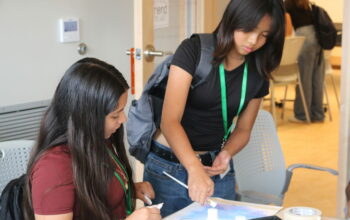A new Dane County health order went into effect Wednesday that removes an outdoor mask mandate and lifts all capacity restrictions for outdoor gatherings.
Public Health Madison & Dane County announced Emergency Order #15 on April 2, citing a continued decrease in COVID-19 cases and hospitalizations. While the order removes the requirement for face coverings outdoors, PHMDC still strongly recommends wearing masks outdoors when it is not possible to maintain a six feet distance from others.
Similarly, though there are no longer specific capacity restrictions for outdoor gatherings, Emergency Order #15 indicates that “Numbers must be limited to ensure individuals who are not members of the same household or living unit maintain six (6) feet physical distancing at all times.”
Outdoors vs. Indoors
Research has shown that the risk of COVID-19 transmission is much lower in outdoor settings.
Dr. Jeff Pothof, chief quality officer at UW Health and emergency medicine physician, explained that the risk of COVID-19 transmission is very much dependent on air flow, so the more stale the air is or the less that air is being exchanged, the more likely that COVID-19 droplets can accumulate and infect people.
“Outdoors there is just constant air movement, even on calm days, there’s nearly an infinite amount of air that’s around you...and that makes it a fair bit more difficult for COVID-19 to infect people outdoors unless you’re really close to other people,” Pothof said.
Furthermore, outdoor environments often allow for more space to physically distance, said Ajay Sethi, who has a doctorate in epidemiology and is an associate professor of Population Health Sciences and faculty director of the Master of Public Health Program at UW-Madison.
Assessing the Risk of Transmission
Both Pothof and Sethi said that the new order could potentially lead to a rise in cases, but they also said the decision was justified based on recent data.
“If we look at the current data, especially for Dane County, our case numbers are lower than they’ve been in the past, so that’s something that goes into this calculation,” Pothof said. “When you look at lower levels of COVID in our community, the likelihood that someone coming to [an] event would have COVID becomes less.”
Pothof explained that when community transmission is low, the likelihood of spreading COVID-19 at an outdoor gathering is much lower as well. However, Pothof also pointed out that maintaining six feet distance at all times is unrealistic, which is why it’s important to make judgements based on local case metrics.
“Whenever you bring large groups of people together, there is always that part of the event where people do get close together,” Pothof said.
Sethi said that while many people are likely experiencing “COVID fatigue” right now and are eager to return to normal life, it is important to stay vigilant about taking precautions.
“With or without [the new] order, we are at risk for spreading COVID, particularly with new variants that are present in the county and across the state, if we don’t take proper precautions,” Sethi said.
Guidance for Vaccinated Individuals
As of Monday, all individuals 16 and older are now eligible to get the COVID-19 vaccine in the state of Wisconsin. Sethi stressed that it’s important for unvaccinated individuals to make their appointments and to get vaccinated as soon as possible, even if it means driving a far distance.
The CDC continues to release new guidance for fully vaccinated individuals, including the ability to “visit inside a home or private setting without a mask with one household of unvaccinated people who are not at risk for severe illness.”
The problem with applying to this to social settings, Sethi said, is that it’s sometimes hard to tell who is at higher risk for COVID-19. Regardless of risk perception, Sethi said that he would continue to wear a mask in public if fully vaccinated. After all, Sethi pointed out, it is recommended by the CDC that vaccinated individuals do so.
Pothof said he worries that people will misinterpret CDC guidance, as vaccinated people can still act as carriers of the coronavirus, and may transmit the virus from one unvaccinated household to another if they gather with several unvaccinated households, even at separate times.
As Sethi said, though vaccinated individuals can feel confident knowing they’re less at risk of becoming infectious, “there’s never a zero risk” that they won’t be able to spread the coronavirus to others.
When making decisions about whether going to a bar or gathering with others is safe, Pothof said that vaccinated individuals should still consider the vaccination status of others, the ability to physically distance in the space, and the air flow, such as visiting an open air bar vs. a dive bar in a basement.
Pothof said that there are two main reasons for considering the health of others. First, Pothof said that “hopefully people care about other people enough where they don’t want to make anyone else sick.”
However, Pothof said there is another consequence to consider. Essentially, every time someone is infected with COVID-19, Pothof said this gives the virus the chance to become a new variant. With enough infections, this could mean that a new variant pops up which current vaccines are ineffective against, therefore coming back to harm those who thought they were “safe” because they were already vaccinated.
Until we reach herd immunity, Sethi stressed that there is always going to be risk involved, but he emphasized that the new health order does not drastically change anything.
“This isn’t a total green light,” Sethi said.





